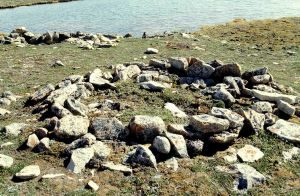
PURDUE UNIVERSITY—WEST LAFAYETTE, Ind.—Two leaded bronze artifacts found in northwestern Alaska are the first evidence that metal from Asia reached prehistoric North America prior to contact with Europeans, according to new Purdue University research.
“This is not a surprise based on oral history and other archaeological finds, and it was just a matter of time before we had a good example of Eurasian metal that had been traded,” said H. Kory Cooper, an associate professor of anthropology, who led the artifacts’ metallurgical analysis. “We believe these smelted alloys were made somewhere in Eurasia and traded to Siberia and then traded across the Bering Strait to ancestral Inuits people, also known as Thule culture, in Alaska. Locally available metal in parts of the Arctic, such as native metal, copper and meteoritic and telluric iron were used by ancient Inuit people for tools and to sometimes indicate status. Two of the Cape Espenberg items that were found—a bead and a buckle—are heavily leaded bronze artifacts. Both are from a house at the site dating to the Late Prehistoric Period, around 1100-1300 AD, which is before sustained European contact in the late 18th century.”
The findings are published in Elsevier’s Journal of Archaeological Science, and the research was funded by the National Science Foundation’s Office of Polar Programs Arctic Social Sciences.
“This article focuses on a small finding with really interesting implications,” said Cooper, who also has a courtesy appointment in materials engineering and is an expert in metallurgy and archaeology in the western Arctic and Subarctic. “This will cause other people to think about the Arctic differently. Some have presented the Arctic and Subarctic regions as backwater areas with no technological innovation because there was a very small population at the time. That doesn’t mean interesting things weren’t happening, and this shows that locals were not only using locally available metals but were also obtaining metals from elsewhere.”
The items were found on Alaska’s northwest coast at Cape Espenberg on the Seward Peninsula where the Thule people lived in houses. The field work was led by Owen K. Mason and John F. Hoffecker, both of the Institute of Arctic and Alpine Research at the University of Colorado, Boulder. From 2009-2011, their team excavated a variety of artifacts including six items with metal. Cooper coordinated the metallurgical analysis.
_______________________________________
A Thule (Copper Inuit) archaeological site. Angar Walk, Wikimedia Commons
___________________________________________________
Metal artifacts are rarely found because they were usually used until they were worn down and, therefore, not well preserved at field sites.
“These items are remarkable due to curation and preservation issues,” Cooper said.
The cylindrical bead and a fragment of a small buckle strap-guide are composed of leaded bronze, which is an alloy of copper, tin and lead. The fragmented leather strap on the buckle provided radiocarbon dating, and the item was dated to 500-800 years old, although the metal could be older.
“The belt buckle also is considered an industrial product and is an unprecedented find for this time,” Cooper said. “It resembles a buckle used as part of a horse harness that would have been used in north-central China during the first six centuries before the Common Era.”
Three of the other four items from another house were determined to be copper – a piece of bone fishing tackle with a copper hook, an eyed copper needle and a small fragment of sheet copper. The final item was a bone fishing lure with iron inset eyes. All items were analyzed with X-ray fluorescence technology.
This house is considerably younger, dating to the 17th to 18th centuries, and is part of a trading network in Alaskan native copper.
Source: Purdue University news release.
________________________________________________________
Also part of the research team was Robert J. Speakman, of the Center for Applied Isotope Studies at the University of Georgia, and Victor Mair, of East Asian Languages and Civilizations at the University of Pennsylvania.
________________________________________________________

______________________________________________
Travel and learn with Far Horizons.
____________________________________________
This richly illustrated issue includes the following stories: Recent findings shedding new light on the whereabouts of the remains of Philip of Macedon, father of Alexander the Great; how an archaeologist-sculptor is bringing bones of the dead back to life; archaeologists uncovering town life at the dawn of civilization; an exclusive interview with internationally acclaimed archaeologist James M. Adovasio about what makes the Meadowcroft Rockshelter prominent in the ongoing search for the first Americans; what archaeologists are finding at the site of the ancient city of Gath, the home town of the biblical Philistine giant, Goliath; and how scientists are redrawing the picture of human evolution in Europe. Find it on Amazon.com.









